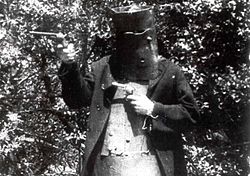Cinema of Australia
| Cinema of Australia | |
|---|---|

The earliest known feature length narrative film in the world was the Australian production, The Story of the Kelly Gang (1906).
|
|
| No. of screens | 1,991 (2011) |
| • Per capita | 9.8 per 100,000 (2011) |
| Main distributors | Roadshow/Warner 26.0% Paramount 19.0% Fox 12.0% |
| Produced feature films (2011) | |
| Fictional | 29 (67.4%) |
| Animated | 4 (9.3%) |
| Documentary | 10 (23.3%) |
| Number of admissions (2011) | |
| Total | 85,000,000 |
| • Per capita | 4.3 (2010) |
| Gross box office (2011) | |
| Total | A$1.09 billion |
| National films | A$45.2 million (4.1%) |
The Australian film industry has its beginnings with the 1906 production of The Story of the Kelly Gang, the earliest feature film ever made. Since then, many films have been produced in Australia, a number of which have received international recognition. Many actors and filmmakers started their careers in Australian films, a large number of whom have acquired international reputations, and a number of whom have found greater financial benefits in careers in larger film producing centres, such as in the United States.
Cinema in Australia began with the first public screenings of films in Australia in October 1896, within a year of the world's first screening in Paris by Lumière brothers. The first Australian exhibition took place at the Athenaeum Hall in Collins Street, Melbourne, to provide alternative entertainment for the dance hall patrons. The venue would continue screenings, but these were all short films.
Commercially successful Australian films have included Paul Hogan's "Crocodile" Dundee, Baz Luhrmann's Moulin Rouge! , and Chris Noonan's Babe. Other award winning productions include Picnic at Hanging Rock, Gallipoli, The Tracker, Shine and Ten Canoes.
Australian actors of renown include Errol Flynn, Peter Finch, Rod Taylor, Guy Pearce, Nicole Kidman, Geoffrey Rush, Toni Collette, Hugh Jackman, Russell Crowe, Eric Bana, Cate Blanchett, Heath Ledger, Chris Hemsworth, Liam Hemsworth and Sam Worthington.
...
Wikipedia
